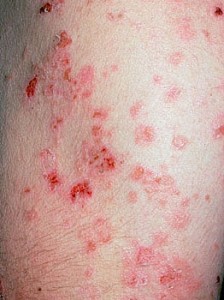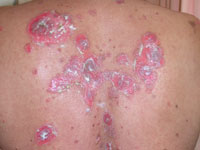Pemphigus vulgaris Definition
Page Contents
- 1 Pemphigus vulgaris Definition
- 2 Pemphigus vulgaris Epidemiology
- 3 Pemphigus vulgaris Signs and Symptoms
- 4 What Causes Pemphigus vulgaris?
- 5 Pemphigus vulgaris Risk Factors
- 6 Pemphigus vulgaris Testing and Diagnosis
- 7 Pemphigus vulgaris Treatment and Management
- 8 Pemphigus vulgaris Complications
- 9 Pemphigus vulgaris Prognosis
- 10 Pemphigus vulgaris Mortality Rate
- 11 Pemphigus vulgaris Pictures
- 12 Pemphigus vulgaris Support Groups
Pemphigus vulgaris (PV) is an autoimmune disease (condition in which the immune system turns against the body itself) characterized by the development of sores and blisters on the skin and mucus membranes [1].
Pemphigus vulgaris Epidemiology
This is a rare disorder having an estimated prevalence of 3.2 in every 100,000 population [2]. It is extremely rare during pregnancy [8] and in children. Males and females are affected equally.
Pemphigus vulgaris Signs and Symptoms
Around half of all sufferers first develop painful sores and blisters in the mouth. This is followed by the development of skin blisters. Skin sores may appear and disappear and may drain, ooze, crust or peel easily. The lesions are often painful [3]. Esophagus is only involved in rare cases.
Additional symptoms include:
- Chills
- Fever
- Rapid spread in the amount of sores
- Crusty sores on the scalp (common)
- Achy joints or muscles [4]
- Sores on anus, throat, genitals and other areas
- Raw, painful skin at the site of blister eruption
The problems are chronic in nature.
What Causes Pemphigus vulgaris?
PV is an autoimmune disorder. The immune system, which produces antibodies against invading microorganisms such as bacteria or viruses, start manufacturing antibodies against specific parts of the body itself in sufferers of autoimmune conditions. In PV patients, antibodies are created against a specific protein that binds skin cells together. Consequently, the adhesion between many skin cells gets destroyed and the cells separate from each other. Fluid accumulates within the isolated cells and creates blisters.
The exact etiology for the immune system turning against the body is not known. The possible trigger factors include infection, viruses or other environmental factors [5]. PV may also arise as a side effect of chelating agents, some blood pressure medications and certain other types of drugs.
Pemphigus vulgaris and Diet
Dietary factors have not been explored although it is best to avoid or limit the intake of:
- Spicy and acidic foods
- Foods that contain Tannins (apples, avocadoes etc.)
- Foods that contain Isothiocyanates (broccoli, brussels sprouts etc.)
- Foods that contain Thiols (chives, garlic etc.)
- Foods that contain Phenols (beverages, candy etc.)
- Foods high in phenols (bananas, Black pepper etc.)
Pemphigus vulgaris Risk Factors
This is a non-contagious disease. It is impossible to understand who will suffer from it. However, the susceptibility is increased in middle-aged and elderly people [6].
Pemphigus vulgaris Testing and Diagnosis
Diagnosis can be difficult as PV is rare and because the blisters also arise with various disorders. Detection usually involves:
- Skin and oral examination
- Complete examination of medical history
- Checking for signs of skin peeling (Nikolsky sign)
- Lab tests like skin biopsy, involving microscopic examination of a blister tissue sample
- Blood tests, to detect desmoglein antibodies
Pemphigus vulgaris Differential Diagnosis
Pemphigus vulgaris can be misdiagnosed as bullous pemphigoid. Doctors should distinguish the signs of PV from the symptoms of such disorders.
Pemphigus vulgaris Treatment and Management
Treatment is aimed at reducing the symptoms and preventing complications. Early cure is more effective. Treatment involves:
Medicines
These typically include:
- Corticosteroids
- Biological therapies
- Immunosuppressants
- Antivirals
- Antibiotics
- Antifungal medications
Hospitalization
Treatment during hospital stay involves:
- Fluids (might be intravenous)
- Anesthetic mouth lozenges
- Intravenous feeding
- Therapeutic plasmapheresis
Treatment helps all sores and blisters disappear fully in around 1/3 cases. Others have to take medications on a lower dose for an indefinite period.
Pemphigus vulgaris Complications
Infection of blisters is one of the common complications of PV. In certain cases, the infection can spread fast to the blood (sepsis) and affect the entire body – thus leading to fatal complications.
Other complications include:
- Infection of the skin
- Side effects associated with steroid and immunosuppressant use
- Death from infection (rare)
- Remission (around 70% in sufferers)
Pemphigus vulgaris Prognosis
PV can become chronic with treatment. The side effects may be acute and even disabling. However, treatment generally stops development of blisters and makes them heal. Risk of death is greatly lowered. The outcome has significantly improved since the introduction of steroids [7].
Pemphigus vulgaris Mortality Rate
If left untreated, complications can be life-threatening (due to dehydration). Mortality rate is high with severe infection. Around 1 in 10 PV sufferers die due to severe side effects of treatment. Older patients are at greater risk.
Pemphigus vulgaris Pictures
The images show the sores and blisters arising in PV patients.
Picture 1 – Pemphigus vulgaris
Picture 2 – Pemphigus vulgaris Image
Pemphigus vulgaris Support Groups
Patients may contact the following associations for information and assistance.
International Pemphigus and Pemphigold (IPPF)
1331 Garden Highway, Ste 100
Sacramento CA 95833
United States of America
British Skin Foundation
4 Fitzroy Square
London
W1T 5HQ
Email: [email protected]
Ph: 0207 391 6347/0207 391 6341


